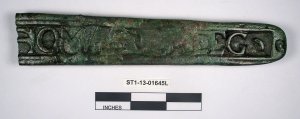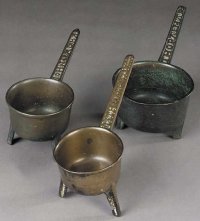Copper Handle

Conservator’s Notes
Prior to treatment, this copper alloy handle was examined visually by a conservator to determine its condition. It was noted that lettering was visible, but partially obscured by a thin layer of dark green corrosion from burial. Presence of dark green colored corrosion is evidence that the corrosion products are stable and not an active threat to the object’s materials and condition. Next, an X-radiograph of the object was studied. X-rays can provide essential information about the condition of an object and if the object is stable enough to proceed with conservation treatment. From these X-rays, various condition and corrosion levels can be seen. Fragile objects have faint or dark-colored spots indicating their weakened state. Light or white colored X-rays indicate the presence of a denser metal core on stable objects. We can also see any decorative details that are obscured or masked by corrosion products and soil accretions. The X-ray of this handle indicated that it has retained its solid metal core and there is no evidence of structural damage, so this object can withstand the treatment process. The X-ray also revealed that one end of the object was broken.
The goal for every treatment is to stabilize the object so that further deterioration of the original materials is terminated. All treatment materials applied to the object to further stabilize it must also be reversible. In this case in particular, revealing the lettering was important as well. Treatment started by soaking the object in a bath of distilled water to remove excess soil. A small soft brush was used to remove the soil and the corrosion layer was reduced mechanically using a fiberglass brush and scalpel under magnification. A quick rinse with acetone was used to remove any cleaning debris and to de-water the object. Once dry, two coats of Acryloid B-72 in acetone was applied to the entire object. The B-72 provides a moisture barrier and allows the object to be handled safely. The handle, like all objects treated, was repackaged in a clean and pierced, archival stable polyethylene bag.
The cleaning of this object revealed evidence of significant wear to the middle of the handle indicating the skillet this handle was originally attached to was often used. This object may have been used while the Calvert family occupied the house or when the house was being used as an inn. Although the words on the handle could not be deciphered, they would indicate the objects maker.
Curator’s Notes
This copper alloy handle is either from a pot or a skillet. Similar handles with either maker’s names or, occasionally, biblical quotes of affirmations occur in collections and have been recovered from 17th-century sites in both the United Kingdom and the U.S. Our specimen bears the name “Thomas” and what appears to be “Skeeg.” Some colleagues have suggested that this might be of Dutch origin, given the name. However, to date no true match has been discovered.


